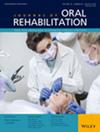Poor oral conditions in the elderly may have numerous effects on general health, including physical fitness and performance.
This study aimed to determine the relationship between oral health and physical function in elderly people.
Physical function and oral health parameters were compared using parametric comparison tests and Pearson correlation analyses. In addition, principal components analysis, hierarchical clustering and multidimensional scaling analysis clustered the patients' physical and oral health scores. The relationship between the groups was also determined using decision tree analysis.
A total of 112 elderly patients participated in the study. Grip strength (GS) was higher in patients with high chewing ability, and Timed Up and Go (TUG) scores were lower in the high oral health group (p < .05). GS was correlated with Decay, Missing, and Filled Teeth Index (DMFT) and the number of remaining and functional teeth (p < .05). According to principal component analysis, it was seen that there were three components (oral, functional and quality of life (QoL) parameters), and the features that were related to each other were gathered together. TUG and GS showed the highest relative importance among physical function criteria in the classification based on chewing ability. They were GS and physical activity for oral health-related QoL.
In the elderly, higher physical function parameters, especially GS may be an indicator of a better oral health and oral health-related QoL. Preventive physical rehabilitation practices, in addition to oral treatments, may be effective in improving oral health in the elderly.


